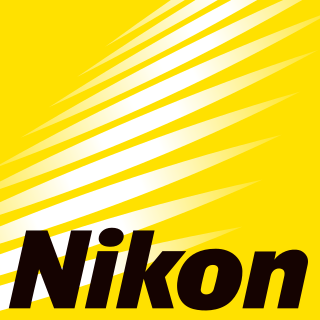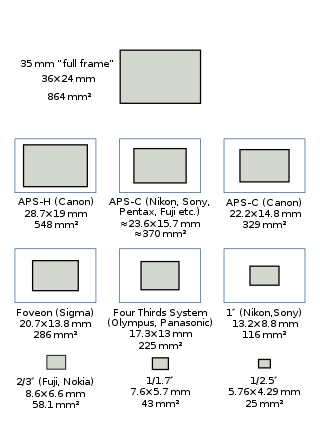
Nikon Corporation is an optics and photographic equipment manufacturer headquartered in Tokyo, Japan. The companies held by Nikon form the Nikon Group.

A digital single-lens reflex camera is a digital camera that combines the optics and mechanisms of a single-lens reflex camera with a solid-state image sensor and digitally records the images from the sensor.

A full-frame DSLR is a digital single-lens reflex camera (DSLR) with a 35 mm image sensor format. Historically, 35 mm was one of the standard film formats, alongside larger ones, such as medium format and large format. The full-frame DSLR is in contrast to full-frame mirrorless interchangeable-lens cameras, and DSLR and mirrorless cameras with smaller sensors, much smaller than a full 35 mm frame. Many digital cameras, both compact and SLR models, use a smaller-than-35 mm frame as it is easier and cheaper to manufacture imaging sensors at a smaller size. Historically, the earliest digital SLR models, such as the Nikon NASA F4 or Kodak DCS 100, also used a smaller sensor.

A mirrorless camera is a digital camera which, in contrast to DSLRs, does not use a mirror in order to ensure that the image presented to the photographer through the viewfinder is identical to that taken by the camera. They have come to replace DSLRs, which have historically dominated interchangeable lens cameras. Other terms include electronic viewfinder interchangeable lens (EVIL) cameras and compact system cameras (CSCs).

The Nikon Expeed image/video processors are media processors for Nikon's digital cameras. They perform a large number of tasks: Bayer filtering, demosaicing, image sensor corrections/dark-frame subtraction, image noise reduction, image sharpening, image scaling, gamma correction, image enhancement/Active D-Lighting, colorspace conversion, chroma subsampling, framerate conversion, lens distortion/chromatic aberration correction, image compression/JPEG encoding, video compression, display/video interface driving, digital image editing, face detection, audio processing/compression/encoding and computer data storage/data transmission.

The Sony α7, α7R, α7S and α7C are four closely related families of full-frame mirrorless interchangeable-lens cameras. The first two were announced in October 2013, the third in April 2014 and the fourth in September 2020. They are Sony's first full-frame mirrorless interchangeable lens cameras and share the E-mount with the company's smaller sensor NEX series.

CFexpress is a standard for removable media cards proposed by the CompactFlash Association (CFA). The standard uses the NVM Express protocol over a PCIe 3.0 interface with 1 to 4 lanes where 1 GB/s data can be provided per lane. There are multiple form factors that feature different PCIe lane counts. One of the goals is to unify the ecosystem of removable storage by being compatible with standards already widely adopted, such as PCIe and NVMe. There already is a wide range of controllers, software and devices that uses these standards, accelerating adoption.

The Sony α9, Model ILCE-9, is a full-frame mirrorless interchangeable-lens camera. It was Sony's flagship camera as of 2017. The camera is not the successor to the α7 line of digital cameras but supplements it. Announced on 19 April 2017, the α9 is characterized by Sony as a true professional mirrorless camera system. The α9 is being compared with the Nikon D5 and the Canon EOS-1D X Mark II.

Nikon Z-mount is an interchangeable lens mount developed by Nikon for its mirrorless digital cameras. In late 2018, Nikon released two cameras that use this mount, the full-frame Nikon Z 7 and Nikon Z 6. In late 2019 Nikon announced their first Z-mount camera with an APS-C sensor, the Nikon Z 50. In July 2020 the entry-level full-frame Z 5 was introduced. In October 2020, Nikon announced the Nikon Z 6II and Nikon Z 7II, which succeed the Z 6 and Z 7, respectively. The APS-C lineup was expanded in July 2021, with the introduction of the retro styled Nikon Z fc, and in October 2021, Nikon unveiled the Nikon Z 9, which effectively succeeds the brand's flagship D6 DSLR. The APS-C lineup was further expanded with the Nikon Z 30, announced at the end of June 2022. The Nikon Z6III was announced in June 2024.

The Nikon Z 7 is a 45.7 megapixel full-frame mirrorless interchangeable-lens camera produced by Nikon. The camera was officially announced on August 23, 2018, for release in September 2018. It was the first camera to use Nikon's new Z-mount system; the second model, released in November 2018, was the 24.5 megapixel Nikon Z 6.

The Nikon Z 6 is a full-frame mirrorless interchangeable-lens camera produced by Nikon. The camera was officially announced on August 23, 2018, to be released in November. Nikon began shipping the Z 6 to retailers on November 16, 2018. This was the second camera to use Nikon's new Z-mount system after the release of the 45.75 megapixel Nikon Z 7 in September 2018.

The Canon RF lens mount is an interchangeable-lens mount developed by Canon for its full-frame mirrorless interchangeable-lens cameras, and featured first by the EOS R, followed by the EOS RP. The RF mount was announced in September 2018. In May 2022, Canon announced APS-C EOS R cameras and RF-S lenses designed for these cameras.

The Canon EOS R is the first full-frame mirrorless interchangeable-lens camera (MILC) produced by Canon. It was announced days after Nikon's first full-frame MILC, the Nikon Z 7, and five years after Sony's first, and was released in October 2018. The camera is the first of Canon's new EOS R system, and the first to use the RF lens mount. The "R" stands for "Reimagine optical excellence".

The Nikon D780 is a full-frame DSLR camera announced by Nikon on January 6, 2020. It was released for purchase on January 23, 2020. It is the successor to the Nikon D750 and has incorporated a lot of technologies from mirrorless Z6 camera.

The Nikon Z 6II is a high-end full-frame mirrorless interchangeable-lens camera (MILC) produced by Nikon and is the successor to the Nikon Z 6. The camera was officially announced on October 14, 2020 alongside the Nikon Z 7II, and became available for purchase on November 5.

The Nikon Z 7II is a high-end full-frame mirrorless interchangeable-lens camera (MILC) produced by Nikon, and is the successor to the Nikon Z 7. The camera was officially announced on October 14, 2020, alongside the Nikon Z 6II, and became available for purchase on November 5. It uses Nikon's Z-mount system.

The Nikon Z 9 is a full-frame mirrorless camera produced by Nikon. The camera was announced on October 28, 2021.

The Nikon Z 8 is a high-end full-frame mirrorless camera produced by Nikon. The camera was announced on May 10, 2023. It is the tenth Z-mount camera body and the seventh full-frame Z-mount body.

The Nikon Z f is a mirrorless interchangeable-lens camera with the Nikon Z-mount with a list price of $1999 body only, in the US.




















